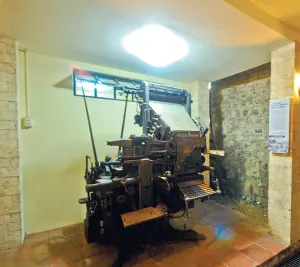Where have they gone? Practices in newspaper production modified or abandoned
Retro


Linotype. First introduced commercially in the USA in 1886, the linotype machine was used by newspapers and general printers to cast lines of type, rather than individual letters, hence its name, “line-o-type.” Sitting in front, the machine operator enters the text on a keyboard. The machine assembles letter molds to make a line. Heated metal is used to cast the assembled line as a single piece, called a “slug,” which awaits placing in a press for printing. After printing, the slugs can be melted again for use in other jobs. The machines and operators above are from Tri-bell Trading, Cebu City.
Where have they gone? Practices in newspaper production modified or abandoned
PACHICO A. SEARES
Sept. 25, 2014
NEWSROOM jobs, practices phased out or changed with new technology and sharper management techniques
Ask a “journ” or masscom graduate what job in a newspaper he can’t apply for. Aside from editor-in-chief, a position rarely vacant, there’s no opening for proofreader. The job isn’t there anymore, hasn’t been there for some decades now.
A proofreader compares the text produced by the linotype and set up by the page composer (“cajista”) and reproduced on paper. He compares the proof with the text written by the reporter and edited by the editor and makes corrections on the proof, which then goes back to the linotypist to correct.

That job, time-consuming and messy (proofreader’s hands perpetually show ink smudges), is gone. Reason is plain: no more need to check production work with the editor’s original manuscript as writing, editing and “pagination” are done on computer. A case of technology changing work flow and procedure.
Is that why there seem to be more typos and other errors in today’s papers?
No, but gatekeeping is shortened and modified.
Proofreading is absorbed into copy-editing, that in turn (at least in Sun.Star) is absorbed into page-editing.
The page editor handles copy editing, headline and caption writing of news stories and features assigned to his page. He picks the photo for the page, does the layout and when all the elements are in place, reviews words (line per line), pictures and art.

Museum piece. After it was replaced by phototypesetting in the 1970s, the linotype machine now properly belongs in a museum, like this one at the Cebu Journalism and Journalists Gallery at Museo Sugbo in Cebu City.
It’s not proofreading anymore. It’s a lot more. It’s correcting grammar and syntax, coherence or unity, spotting factual errors. It’s guarding against libel, bad taste, unfairness. It’s watching out for gaps in the story, meanings obscured or warped. Multitasking? You bet.
Doesn’t that swamp the page editor with more work than he can handle? Usually, there are only three or four stories on a page, sometimes even less, what with the ads that Marketing tucks in before pages go to Editorial. The page editor is not loaded with more work than skill or experience allows.
There are other newsroom jobs and practices not missed by the new “journ” or masscom graduate because they had gone for some time already. To name a few:
“Strippers.” They were people who placed negatives of text and photos on the page before they were transferred on plate that would go to the printing machine. Their work involved editorial overseeing so that for some time strippers were part of the newsroom or a shouting-distance nearby. And during hot nights, when air-con bogged down, they’d literally strip, waist up.
“Rewrite man.” Or woman, usually a senior editor who’d write the story from facts phoned in by a reporter. The reporter was far away and couldn’t get back on time to write the story himself.
No more need for rewrite. These days, the reporter, no matter where, provided his laptop or notebook is powered, can send the story in less time than a “rewrite” can get the facts and write it. No, not true what you see in the movies: an editor hollering for “Rewrite!”
Rewriting done today is overhauling a poorly done piece that the editor can’t discard or send back to the reporter. Or adding a new lead or some facts into a story earlier filed and edited, which can’t be emailed and has to be phoned in.
“Photo couriers.” When an important event was held out of town and the photographer couldn’t get back for the deadline, couriers would be used to get the film. Not a full-time job, usually piecework but crucial.
A roll of film from a photographer sent to Manila to shoot Edsa 1 photos had to be sent by a courier who’d go to the airport and ask someone (a passenger on return flight to Cebu) who’d give it to another courier waiting at the airport who’d rush back to the newsroom where a photographer waited to develop the film, for an editor to pick from, and for the cameraman to shoot and the stripper to paste on and the plate-maker to put on plate, before the printing machine could roll.

Proof press, Tri-bell Trading, Cebu City. This hand-operated machine was used to make test prints from metal types, so printers could check for errors in the text before final printing on the letterpress. Proof press use declined when offset printing, computer typesetting and electronic pre-press systems gained ground in the 1960s to the 1980s.
No need for couriers now with the technology of transmitting photos from there to here in seconds and putting the chosen photo on the page that will be sent on “flight” to the printers.
In the jobs gone or changed, skill and experience of the reporter or editor remain in full use, perhaps the task even made easier and room for creativity made larger.
And they don’t write “30” anymore at the end of their story. Maybe just as well. Papers that allow occasional cliches use “30” in the headline of an obit for a journalist. 

Eddie O. Barrita. Lawyer-journalist, head of the Philippines News Agency (PNA) Cebu bureau. PNA may be the only wire agency left operating in the country.
Wire reporting is not dead

Interview with Eddie O. Barrita by Pachico A. Seares
Are wire news agencies already extinct?
No. There’s the Associated Press (AP) as well as Agence France Presse (AFP) and Reuters. PNA, the country’s best and only wire news agency, is very much alive. An endangered species maybe but not extinct.
Granted that PNA is still operating, how much wire-agency style of reporting does it still practice?
We report news and features from Cebu and other key areas to Manila. Manila sends them out, along with news and features from the capital region, to its clients, mostly newspapers and government offices.
PNA was known for gather-and-write-as-the-event-happens kind of reporting. Some called that blow-by-blow coverage or shovel-by-shovel account in covering burial of VIPs. PNA still does that when a big event happens and, of course, presidential visits.
So speedy, spare and crisp kind of writing is no longer being done? Does that mean the death of wire news reporting?
No, fast, as-it-happens, wire news agency style of reporting is still useful.
News cycles are shorter, especially for broadcast and online newspaper editions.
Demand for the news as soon as it’s available is more pressing than ever. News consumers must be supplied the commodity whenever and wherever they want it. That requires skills of the wire news agency journalist.
The wire news agency must be distinguished from the skills of the wire news agency journalist, which must now be learned also in news outfits other than a wire news agency.
“Korek ka dyan.” Other news organizations can train their journalists, depending upon their requirements, some of which are similar to those of a wire news agency.
The services of a wire news agency are now being provided by similar outfits, only with another name or for a modified clientele.
The Inquirer has its network of correspondents that operates wire-news-agency style but for its own use. So does Sun.Star Network Exchange (Sunnex), with its affiliate papers doing pretty much the same work as news bureaus.
That’s also true in other parts of the world. We still have the Associated Press, Agence France Presse and Reuters which each does the work of a wire news agency in its strict sense. And of course, every government has a wire news agency of its own.
Can you still report the way a “wire reporter” does, that is, under tremendous time pressure?
I can. Given, ha ha, enough time.
